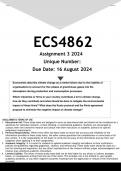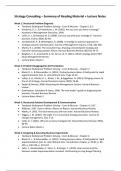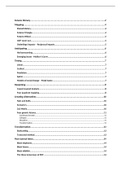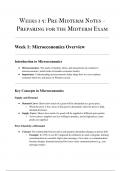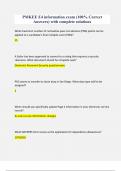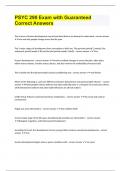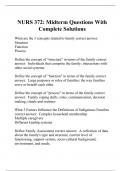Chapter 15
SEGMENT AND INTERIM FINANCIAL REPORTING
Answers to Questions
1 Operating segments under US GAAP and IFRS 8 has similar characteristics:
a. Component of an entity that engages business activity from which it may incur
expenses and earn revenues
b. Component of an entity whose operating results are reviewed regularly by the entity's
chief operating decision maker to make decisions about resources to be allocated to the
segment and assess its performance
c. Component of an entity for which discrete financial information is available
2 A reportable segment is an operating segment, either single or aggregated, for which information
has to be reported under FASB ASC Topic 280. An operating segment is a reportable segment if
(a) its revenue is 10 percent or more of the combined revenue of all operating segments, (b) its
absolute profit or loss is 10 percent or more of the greater of combined profit of all segments that
have profit or combined losses of all segments that have losses, or (c) its assets are 10 percent or
more of the combined assets of all operating segments.
3 The items that needs reconciliations are:
a. The total of the reportable segment’s revenues and the reported consolidated revenues
b. The total of the reportable segment’s profit and loss and consolidated income before
taxes
c. The total of the reportable segment’s assets to consolidated assets
d. The total of the reportable segment’s amounts for any other significant items with the
corresponding consolidated amount.
4 The 10 percent revenue test applies to the $480,000. Revenue for purposes of FASB ASC Topic
280 includes revenue from both external and intersegment customers.
5 An industry segment is a reportable segment under the 10 percent operating profit test if its
operating profit or loss, in absolute amount, equals or is greater than the greater of combined
operating profits for all operating segments having operating profits or the absolute value of the
combined operating losses for all operating segments having operating losses.
6 A segment is a reportable segment under the 10 percent asset test if its assets are 10 percent or
more of the combined assets of all operating segments. The allocation of general corporate
assets depends on the internal operations of the enterprise. The key is the asset figure given to
the chief operating decision maker on which he or she evaluates performance. If corporate assets
are allocated, they become part of the reconciliation between the reportable segments’ assets and
consolidated assets.
7 A segment is a reportable segment under the 10 percent revenue test if its intersegment and
external sales is 10 percent or more of the combined intersegment and external sales of all the
operating segments.
8 No. If the combined revenue from sales to external customers is less than 75 percent of total
consolidated revenues, additional operating segments must be identified as reportable segments
until the 75 percent test is met. Either some of the remaining segments must be aggregated, if
they meet the aggregation criteria, so that the combined segment meets the materiality criteria of
Copyright © 2015 Pearson Education Limited
,15-2 Segment and Interim Financial Reporting
10%, or one or more of the five operating segments that were not reportable segments under the
10 percent tests must be identified as reportable segments.
9 The following information must be disclosed for reportable segments and for the remainder of
the enterprise’s operating segments and other business activities in the aggregate:
a Revenue, with separate amounts to unaffiliated and affiliated customers, and disclosure
of the basis of accounting for intersegment sales.
b A measure of profit or loss, based on the information reviewed by the chief operating
officer.
c Assets for each reportable segment.
d Interest revenue
e Interest expense
f Aggregate amount of depreciation, depletion, and amortization expense.
g Unusual items as described in paragraph 26 of APB Opinion No. 30.
h Equity in the net income of investees accounted for by the equity method.
i Income tax expense or benefit.
j Extraordinary items.
k Significant noncash items other than depreciation, depletion, and amortization.
10 If the enterprise is segmented on a geographic basis, complete segment information would be
supplied by country of operation. If a different criteria is used for segmentation, more limited
geographic information is supplied. Revenues and long lived assets attributed to the country of
domicile and all foreign operations are disclosed. Any single country with material operations
must also be disclosed separately.
11 The fact of and the amount of revenue from each customer must be disclosed if 10 percent or
more of an enterprise’s revenue is derived from that customer. If 10 percent or more of an
enterprise’s revenue is derived from sales to the federal government, or to a state, local, or
foreign governmental unit, that fact and the amount of revenue must be disclosed. The identity
of the segment making such sales must be disclosed, but the customer need not be identified by
name.
12 The requirements of FASB ASC Topic 280 do apply to interim financial statements. Like other
aspects of interim reporting, segment disclosure is more limited in the interim reports than in the
annual reports. Required disclosure for each reportable segment in the interim reports include:
(1) revenues from external customers, (2) intersegment revenues, (3) a measure of segment
profit or loss, (4) total assets for which there has been a material change since the amount
disclosed in the annual report, (5) a description of any changes in the basis for segmentation or
the basis of measurement of segment profit or loss, (6) a reconciliation of total reportable
segment profit or loss and consolidated income before income taxes.
13 An annual effective tax rate is computed as the sum of estimated income taxes for each quarter
of the year, divided by the estimated income for the year. This approach spreads any progression
in tax rates over the entire year in accordance with the integral theory of interim reporting.
14 There are two disclosure requirement differences between IFRS and US GAAP:
a. Non-current assets in US GAAP is only for hard assets, while in IFRS intangibles are
included.
b. Disclosure of segment liabilities is not required in US GAAP, while in IFRS it is required ifsuch
a measure is regularly provided to the decision maker.
Copyright © 2015 Pearson Education Limited
, Chapter 15 15-3
15 The major differences of interim reporting between US GAAP and IFRS is that IFRS preferred
using the discrete theory, hence treating each interim period as an independent period so that
expenses from one period does not associate with any other period and need to be accrued within
the current interim period.
US GAAP on the other hand preferred the integral theory, in which interim reporting is viewed
as an integral part of the annual period, so that annual expenses can be accrued within all interim
periods based on management’s estimates.
SOLUTIONS TO EXERCISES
Solution E15-1
1 d 4 b
2 a 5 d
3 d 6 b
Solution E15-2
1 Revenue tests
10% revenue test:
Revenue from Affiliated Reportable Segment
and Unaffiliated Customers Test Value $430,000
Concrete and stone $ 400,000 No
products
Construction 1,000,000 Yes
Lumber and wood products 1,800,000 Yes
Building materials 1,000,000 Yes
Other 100,000 No
$4,300,000
75% revenue test:
Combined Revenue from Combined Revenue from
Reportable Segments to All Segments to
Unaffiliated Customers Unaffiliated Customers
Concrete and stone $ 400,000
products
Construction $ 1,000,000 1,000,000
Lumber and wood products 1,000,000 1,000,000
Building materials 600,000 600,000
Other 100,000
$ 2,600,000 $ 3,100,000
Since the $2,600,000 combined revenue from reportable segments to
unaffiliated customers is greater than 75% of $3,100,000 revenue
for all unaffiliated customers, no additional segments have to be
reported.
2 Schedule for disclosing revenue by segment:
Lumber Building
Construction and Wood Materials Other Totals
Unaffiliated
sales $1,000,000 $1,000,000 $600,000 $500,000 $3,100,000
Copyright © 2015 Pearson Education Limited
SEGMENT AND INTERIM FINANCIAL REPORTING
Answers to Questions
1 Operating segments under US GAAP and IFRS 8 has similar characteristics:
a. Component of an entity that engages business activity from which it may incur
expenses and earn revenues
b. Component of an entity whose operating results are reviewed regularly by the entity's
chief operating decision maker to make decisions about resources to be allocated to the
segment and assess its performance
c. Component of an entity for which discrete financial information is available
2 A reportable segment is an operating segment, either single or aggregated, for which information
has to be reported under FASB ASC Topic 280. An operating segment is a reportable segment if
(a) its revenue is 10 percent or more of the combined revenue of all operating segments, (b) its
absolute profit or loss is 10 percent or more of the greater of combined profit of all segments that
have profit or combined losses of all segments that have losses, or (c) its assets are 10 percent or
more of the combined assets of all operating segments.
3 The items that needs reconciliations are:
a. The total of the reportable segment’s revenues and the reported consolidated revenues
b. The total of the reportable segment’s profit and loss and consolidated income before
taxes
c. The total of the reportable segment’s assets to consolidated assets
d. The total of the reportable segment’s amounts for any other significant items with the
corresponding consolidated amount.
4 The 10 percent revenue test applies to the $480,000. Revenue for purposes of FASB ASC Topic
280 includes revenue from both external and intersegment customers.
5 An industry segment is a reportable segment under the 10 percent operating profit test if its
operating profit or loss, in absolute amount, equals or is greater than the greater of combined
operating profits for all operating segments having operating profits or the absolute value of the
combined operating losses for all operating segments having operating losses.
6 A segment is a reportable segment under the 10 percent asset test if its assets are 10 percent or
more of the combined assets of all operating segments. The allocation of general corporate
assets depends on the internal operations of the enterprise. The key is the asset figure given to
the chief operating decision maker on which he or she evaluates performance. If corporate assets
are allocated, they become part of the reconciliation between the reportable segments’ assets and
consolidated assets.
7 A segment is a reportable segment under the 10 percent revenue test if its intersegment and
external sales is 10 percent or more of the combined intersegment and external sales of all the
operating segments.
8 No. If the combined revenue from sales to external customers is less than 75 percent of total
consolidated revenues, additional operating segments must be identified as reportable segments
until the 75 percent test is met. Either some of the remaining segments must be aggregated, if
they meet the aggregation criteria, so that the combined segment meets the materiality criteria of
Copyright © 2015 Pearson Education Limited
,15-2 Segment and Interim Financial Reporting
10%, or one or more of the five operating segments that were not reportable segments under the
10 percent tests must be identified as reportable segments.
9 The following information must be disclosed for reportable segments and for the remainder of
the enterprise’s operating segments and other business activities in the aggregate:
a Revenue, with separate amounts to unaffiliated and affiliated customers, and disclosure
of the basis of accounting for intersegment sales.
b A measure of profit or loss, based on the information reviewed by the chief operating
officer.
c Assets for each reportable segment.
d Interest revenue
e Interest expense
f Aggregate amount of depreciation, depletion, and amortization expense.
g Unusual items as described in paragraph 26 of APB Opinion No. 30.
h Equity in the net income of investees accounted for by the equity method.
i Income tax expense or benefit.
j Extraordinary items.
k Significant noncash items other than depreciation, depletion, and amortization.
10 If the enterprise is segmented on a geographic basis, complete segment information would be
supplied by country of operation. If a different criteria is used for segmentation, more limited
geographic information is supplied. Revenues and long lived assets attributed to the country of
domicile and all foreign operations are disclosed. Any single country with material operations
must also be disclosed separately.
11 The fact of and the amount of revenue from each customer must be disclosed if 10 percent or
more of an enterprise’s revenue is derived from that customer. If 10 percent or more of an
enterprise’s revenue is derived from sales to the federal government, or to a state, local, or
foreign governmental unit, that fact and the amount of revenue must be disclosed. The identity
of the segment making such sales must be disclosed, but the customer need not be identified by
name.
12 The requirements of FASB ASC Topic 280 do apply to interim financial statements. Like other
aspects of interim reporting, segment disclosure is more limited in the interim reports than in the
annual reports. Required disclosure for each reportable segment in the interim reports include:
(1) revenues from external customers, (2) intersegment revenues, (3) a measure of segment
profit or loss, (4) total assets for which there has been a material change since the amount
disclosed in the annual report, (5) a description of any changes in the basis for segmentation or
the basis of measurement of segment profit or loss, (6) a reconciliation of total reportable
segment profit or loss and consolidated income before income taxes.
13 An annual effective tax rate is computed as the sum of estimated income taxes for each quarter
of the year, divided by the estimated income for the year. This approach spreads any progression
in tax rates over the entire year in accordance with the integral theory of interim reporting.
14 There are two disclosure requirement differences between IFRS and US GAAP:
a. Non-current assets in US GAAP is only for hard assets, while in IFRS intangibles are
included.
b. Disclosure of segment liabilities is not required in US GAAP, while in IFRS it is required ifsuch
a measure is regularly provided to the decision maker.
Copyright © 2015 Pearson Education Limited
, Chapter 15 15-3
15 The major differences of interim reporting between US GAAP and IFRS is that IFRS preferred
using the discrete theory, hence treating each interim period as an independent period so that
expenses from one period does not associate with any other period and need to be accrued within
the current interim period.
US GAAP on the other hand preferred the integral theory, in which interim reporting is viewed
as an integral part of the annual period, so that annual expenses can be accrued within all interim
periods based on management’s estimates.
SOLUTIONS TO EXERCISES
Solution E15-1
1 d 4 b
2 a 5 d
3 d 6 b
Solution E15-2
1 Revenue tests
10% revenue test:
Revenue from Affiliated Reportable Segment
and Unaffiliated Customers Test Value $430,000
Concrete and stone $ 400,000 No
products
Construction 1,000,000 Yes
Lumber and wood products 1,800,000 Yes
Building materials 1,000,000 Yes
Other 100,000 No
$4,300,000
75% revenue test:
Combined Revenue from Combined Revenue from
Reportable Segments to All Segments to
Unaffiliated Customers Unaffiliated Customers
Concrete and stone $ 400,000
products
Construction $ 1,000,000 1,000,000
Lumber and wood products 1,000,000 1,000,000
Building materials 600,000 600,000
Other 100,000
$ 2,600,000 $ 3,100,000
Since the $2,600,000 combined revenue from reportable segments to
unaffiliated customers is greater than 75% of $3,100,000 revenue
for all unaffiliated customers, no additional segments have to be
reported.
2 Schedule for disclosing revenue by segment:
Lumber Building
Construction and Wood Materials Other Totals
Unaffiliated
sales $1,000,000 $1,000,000 $600,000 $500,000 $3,100,000
Copyright © 2015 Pearson Education Limited

